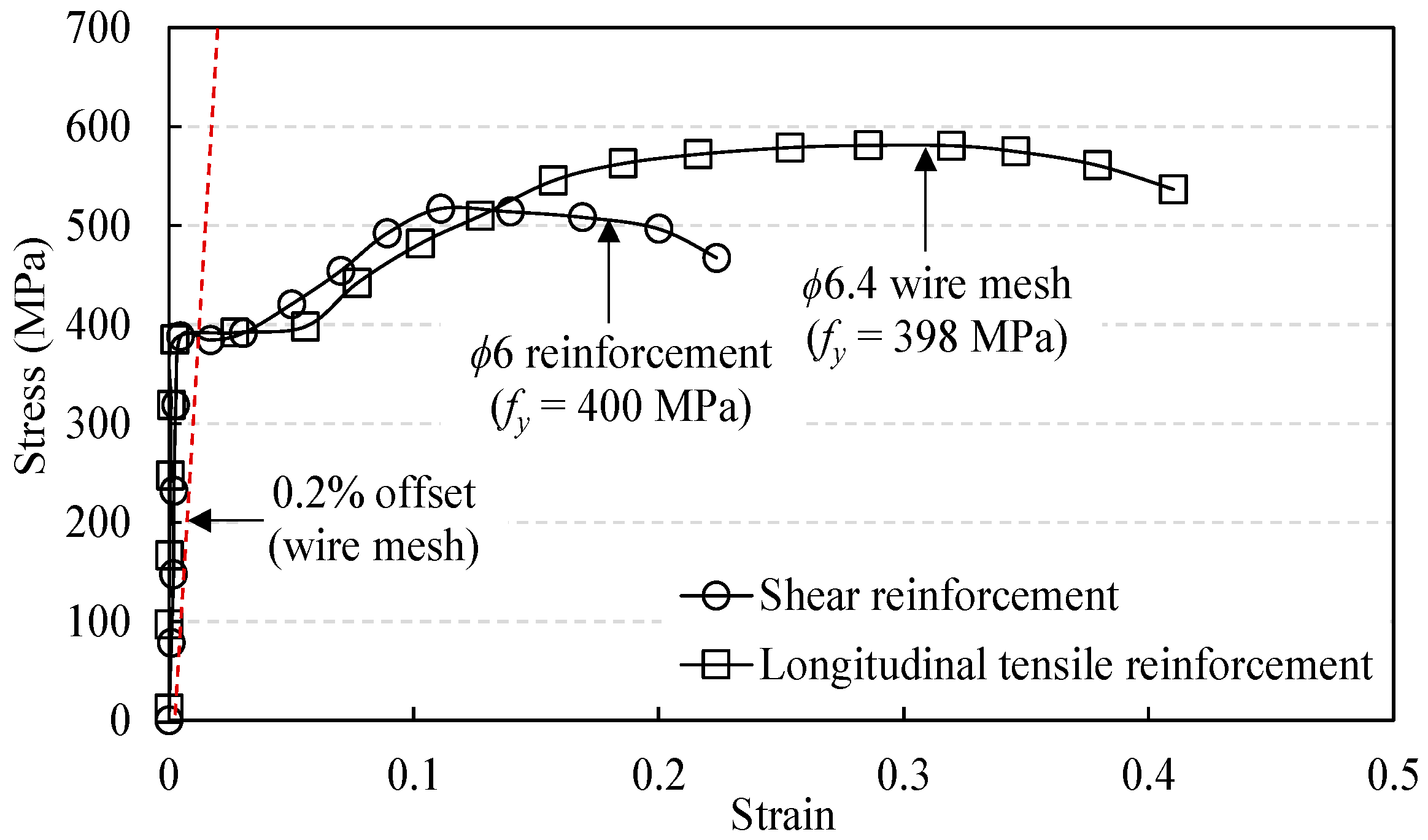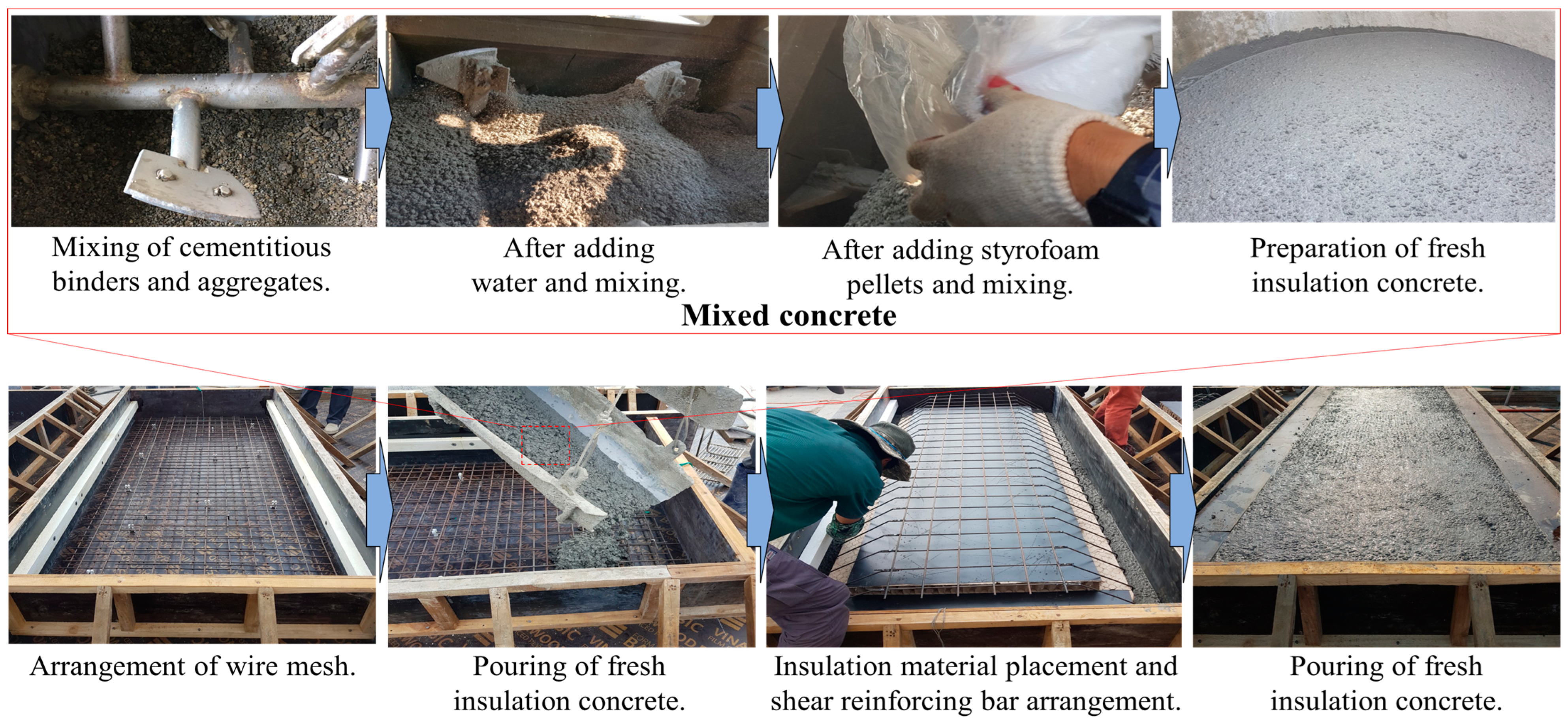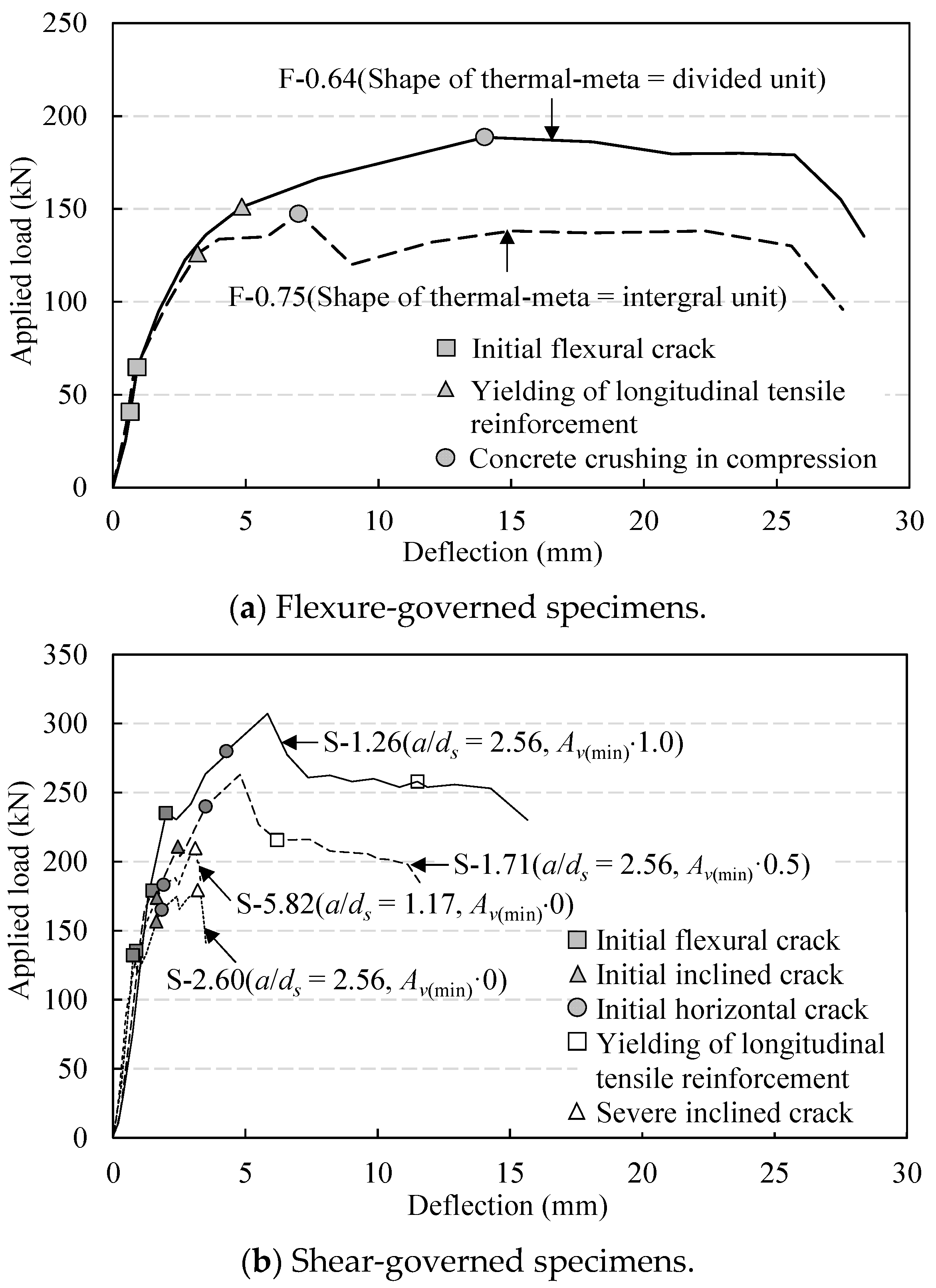Flexural–Shear Performance of Lightweight Concrete Panels with High Insulation Capacity
Abstract
:1. Introduction
2. Research Significance
3. Experimental Details
3.1. Material Properties
3.2. Specimen Details
3.3. Test Procedure and Instrumentation
4. Test Results and Discussion
4.1. Crack Propagation and Failure Mode
4.2. Load–Deflection Relationship
4.3. Strain in Longitudinal Tensile Reinforcement
4.4. Flexural and Shear Load Capacity
4.5. Displacement Ductility Ratio
5. Comparison with Predictions
5.1. Cracking Capacity
5.2. Moment and Shear Capacity
5.3. Classification of Grade for Load Capacity
6. Conclusions
- 1
- The failure mode of the insulation panels with > 2.6 was similar to that of shear governed reinforced concrete beams, exhibiting severe diagonal cracks in the shear span and elastic state of the longitudinal tensile reinforcement.
- 2
- The flexural behavior of the insulation panels with ≤ 0.75 was ductile and showed plastic flow in the load–deflection curve with the yielding of longitudinal reinforcements before the peak load.
- 3
- The displacement ductility ratio of the insulation panels with ≤ 0.75 was more than 2.57, which was comparable to that of conventional lightweight aggregate concrete beams with the minimal reinforcement ratio specified in ACI 318-19.
- 4
- The ACI 318-19 equations overestimated the flexural cracking moments, but underestimated the nominal moment capacities of insulation panels with ≤ 0.75. Therefore, ACI 318-19 should be underestimated by 47% when estimating the flexural cracking moment of the insulation panels.
- 5
- The ACI 318-19 equations overestimated the initial diagonal cracking and maximal shear capacities of the insulation panels. When the values increased, the overestimations were notable, particularly for initial diagonal cracking shear capacity. Therefore, when estimating the shear capacity of the insulation panels using ACI 318-19, shear capacity should be designed considering the overestimation of ACI 318-19.
- 6
- All the developed insulation panels were classified as Grade 1, specified in KS F 4736, indicating good lateral load resistance.
- 7
- On the basis of the test results, the developed panels must be designed to a have moment–shear ratio of 0.75 or less to fulfil the ductile response under extreme lateral loads.
Author Contributions
Funding
Institutional Review Board Statement
Informed Consent Statement
Data Availability Statement
Conflicts of Interest
References
- Ng, S.C.; Low, K.S. Thermal Conductivity of Newspaper Sandwiched Aerated Lightweight Concrete Panel. Energy Build. 2010, 42, 2452–2456. [Google Scholar] [CrossRef]
- Marani, A.; Madhkhan, M. Thermal Performance of Concrete Sandwich Panels Incorporating Phase Change Materials: An Experimental Study. J. Mater. Res. Technol. 2021, 12, 760–775. [Google Scholar] [CrossRef]
- Yang, K.H.; Mun, J.H. Evaluation of Flexural and Shear Behaviors of Lightweight Concrete Eco-Thermal Panel with Bottom Ash Aggregate and Air Foam. J. Korea Conc. Inst. 2021, 33, 245–251. [Google Scholar] [CrossRef]
- Fernando, P.L.N.; Jayasinghe, M.T.R.; Jayasinghe, C. Structural Feasibility of Expanded Polystyrene (EPS) Based Lightweight Concrete Sandwich Wall Panels. Constr. Build. Mater. 2017, 139, 45–51. [Google Scholar] [CrossRef]
- Kim, J.W.; Yang, K.H.; Mun, J.H. Evaluation on Mechanical Properties and Thermal Resistance of Lightweight Concrete Using Bottom Ash Aggregates and Expanded Polystyrene Bead. J. Korea Conc. Inst. 2021, 33, 567–577. [Google Scholar]
- Kim, K.C.; Koh, K.T.; An, G.H.; Son, M.S.; Kim, B.S. Evaluation of Flexural Behavior of Lightweight Precast Panel with Ultra High Performance Concrete. J. Korean Recycl. Constr. Resour. Inst. 2020, 8, 269–275. [Google Scholar]
- Pessiki, S.; Mlynarczyk, A. Experimental Evaluation of the Composite Behavior of Precast Concrete Sandwich Wall Panels. PCI J. 2003, 48, 54–71. [Google Scholar] [CrossRef]
- Tomlinson, D.; Fam, A. Flexural Behavior of Precast Concrete Sandwich Wall Panels with Basalt FRP and Steel Reinforcement. PCI J. 2015, 60, 51–70. [Google Scholar] [CrossRef]
- O’Hegarty, R.; Kinnane, O. Review of Precast Concrete Sandwich Panels and their Innovations. Constr. Build. Mater. 2020, 233, 117–145. [Google Scholar] [CrossRef]
- Acharya, M.; Gurung, K.; Mashal, M. Full-Scale Flexural Testing of Slabs made of Modular Structural Concrete Insulated Panels. PCI J. 2022, 67, 55–76. [Google Scholar] [CrossRef]
- ACI Committee 318. Building Code Requirements for Structural Concrete (ACI 318-19) and Commentary; American Concrete Institute: Farmington Hills, MI, USA, 2019. [Google Scholar]
- KATS. Extrusion Lightweight Concrete Panels (KS F 4736); Korean Standard Association: Seoul, Korea, 2018. [Google Scholar]
- ASTM C330; Annual Book of ASTM Standards: V. 4.02. ASTM International: West Conshohocken, PA, USA, 2012.
- KCI. Korea Concrete Institute Model Code (KCI 2017); Kimoondang Publishing Company, Korea Concrete Institute: Seoul, Korea, 2017. [Google Scholar]
- Im, C.R.; Yang, K.H.; Mun, J.H. Assessment of Maximum Longitudinal Reinforcement Ratios for Reinforced Lightweight Aggregate Concrete Beams. J. Korea Conc. Inst. 2022, 33, 419–425. [Google Scholar]
- Xie, Q.; Wang, S.; Liu, C. Axial Compression Behavior of a New Type of Prefabricated Concrete Sandwich Wall Panel. Mater. Sci. Eng. 2018, 317, 1–6. [Google Scholar]
- Joseph, J.D.R.; Prabakar, J.; Alagusundaramoorthy, P. Precast Concrete Sandwich One-Way Slabs Under Flexural Loading. Eng. Struct. 2017, 138, 447–457. [Google Scholar] [CrossRef]
- Park, R.; Paulay, T. Reinforced Concrete Structures. Wiley Interscience Publication: New York, NY, USA, 1975; pp. 196–199. [Google Scholar]
- Ahmed, A.M.; Ahlam, S.M.; Wissam, D.S. Effect of Longitudinal Steel Reinforcement Ratio on Deflection and Ductility in Reinforced Concrete Beams. Mater. Sci. Eng. 2020, 888, 1–6. [Google Scholar]










| Type | Maximal Size (mm) | Surface Density (kg/m3) | Dried Density (kg/m3) | Water Absorption (%) | Fineness Modulus | |
|---|---|---|---|---|---|---|
| Bottom ash aggregates | Coarse aggregate | 13 | 1180 | 900 | 15.3 | 6.55 |
| Fine aggregate | 4 | 1790 | 1520 | 19.1 | 2.74 | |
| Styrofoam pellets | 5 | 33 | 31 | 3.1 | 3.82 | |
| Designed Values | Styrofoam Pellet Volume Ratio (%) | Unit Weight (kg/m3) | Measured Average Values | |||||||||||
|---|---|---|---|---|---|---|---|---|---|---|---|---|---|---|
(MPa) | (kg/m3) | OPC | GGBS | FA | Bottom Ash Coarse Aggregate | Bottom Ash Fine Aggregate | Styrofoam Pellets | (MPa) | (kg/m3) | |||||
| 13 mm | 2 mm under | 2–4 mm | ||||||||||||
| 12 | 1400 | 30 | 42 | 7.5 | 135 | 135 | 225 | 90 | 400 | 308 | 132 | 2.5 | 12.3 | 1408 |
| Specimens | Target Behavior | Main Parameters | Longitudinal Tensile Reinforcement | Moment–Shear Ratio | |||||||||
|---|---|---|---|---|---|---|---|---|---|---|---|---|---|
(MPa) | (kg/m3) | Type of Wire Mesh (mm) | Shape of Thermal Meta | Arrangement | (kN·m) | (kN) | (=) | ||||||
| F-0.64 | Flexure | 12.2 | 1403 | 100 × 100 | Divided unit | 2.56 | 0.00053 | 12—ϕ 6.4 | 0.0015 | 0.0015 | 69 | 140 | 0.64 |
| F-0.75 | 12.4 | 1410 | 100 × 100 | Integral unit | 54 | 94 | 0.75 | ||||||
| S-1.25 | Shear | 12.8 | 1420 | 50 × 340 | 0.00062 | 28—ϕ 6.4 | 0.0036 | 0.0015 | 244 | 252 | 1.25 | ||
| S-1.71 | 12.2 | 1406 | 50 × 170 | 0.00031 | 243 | 185 | 1.71 | ||||||
| S-2.60 | 12.6 | 1412 | 50 × 0 | - | 243 | 122 | 2.60 | ||||||
| S-5.82 | 12.1 | 1406 | 50 × 0 | 1.17 | - | 242 | 119 | 5.82 | |||||
| Researcher | Specimens | Test Results | Predicted Values Obtained by ACI 318-19 | Comparison (Test Results/Predicted Values) | |||||||||
|---|---|---|---|---|---|---|---|---|---|---|---|---|---|
(kN) | (kN) | (kN) | (mm) | (mm) | (kN·m) [1] | (kN·m) [2] | (kN·m) [3] | (kN·m) [4] | [1]/[3] | [2]/[4] | |||
| This study | F-0.64 | 62.4 | 151 | 189 | 4.86 | 14 | 2.88 | 21.9 | 72.3 | 36.2 | 68.6 | 0.61 | 1.05 |
| F-0.75 | 50.2 | 126 | 148 | 2.72 | 7 | 2.57 | 15.4 | 56.6 | 34.2 | 53.7 | 0.45 | 1.05 | |
| Acharya et al. [10] | A-1 | 14.5 | 25.1 | 29.1 | 29.2 | 58.4 | 2..01 | 10.8 | 21.8 | 14.9 | 18.6 | 0.73 | 1.17 |
| A-2 | 15.2 | 26.9 | 29.8 | 36.8 | 84.3 | 2.29 | 11.4 | 22.3 | 14.9 | 18.6 | 0.76 | 1.20 | |
| A-3 | 14.5 | 26.7 | 30.7 | 30.5 | 67.3 | 2.21 | 10.9 | 23.0 | 14.9 | 18.6 | 0.73 | 1.24 | |
| Specimen | Test Result | ACI 318-19 | Comparison | |||
|---|---|---|---|---|---|---|
(kN) [4] | (kN) [5] | (kN) [6] | (kN) [7] | [4]/[6] | [5]/[7] | |
| S-1.26 | 115 | 154 | 123 | 252 | 0.94 | 0.61 |
| S-1.71 | 106 | 132 | 120 | 185 | 0.88 | 0.71 |
| S-2.60 | 78 | 89 | 122 | 122 | 0.64 | 0.73 |
| S-5.82 | 91 | 105 | 119 | 119 | 0.77 | 0.88 |
| Grade | 1 | 2 | 3 | 4 | 5 |
|---|---|---|---|---|---|
| Load range (kPa) | >3.4 | 2.8–3.4 | 2.2–2.8 | 1.7–2.2 | <1.7 |
| Transformed load ranges from the designed section details of the developed panels (kN) | >10.2 | 8.4–10.2 | 6.6–8.4 | 5.1–6.6 | <5.1 |
Publisher’s Note: MDPI stays neutral with regard to jurisdictional claims in published maps and institutional affiliations. |
© 2022 by the authors. Licensee MDPI, Basel, Switzerland. This article is an open access article distributed under the terms and conditions of the Creative Commons Attribution (CC BY) license (https://creativecommons.org/licenses/by/4.0/).
Share and Cite
Yang, K.-H.; Mun, J.-H.; Kim, J.-W.; Lee, S.-J. Flexural–Shear Performance of Lightweight Concrete Panels with High Insulation Capacity. Buildings 2022, 12, 1741. https://doi.org/10.3390/buildings12101741
Yang K-H, Mun J-H, Kim J-W, Lee S-J. Flexural–Shear Performance of Lightweight Concrete Panels with High Insulation Capacity. Buildings. 2022; 12(10):1741. https://doi.org/10.3390/buildings12101741
Chicago/Turabian StyleYang, Keun-Hyeok, Ju-Hyun Mun, Jong-Won Kim, and Sung-Jin Lee. 2022. "Flexural–Shear Performance of Lightweight Concrete Panels with High Insulation Capacity" Buildings 12, no. 10: 1741. https://doi.org/10.3390/buildings12101741
APA StyleYang, K.-H., Mun, J.-H., Kim, J.-W., & Lee, S.-J. (2022). Flexural–Shear Performance of Lightweight Concrete Panels with High Insulation Capacity. Buildings, 12(10), 1741. https://doi.org/10.3390/buildings12101741







